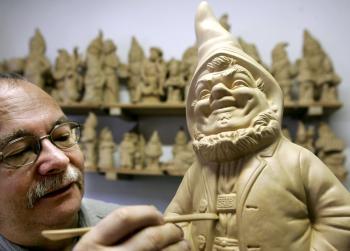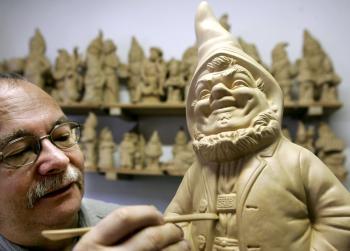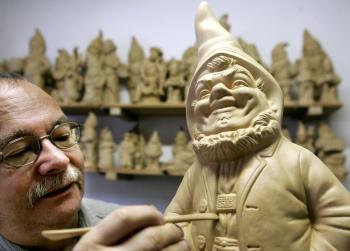Every culture has its myths—tales of monsters and humanoids, spirits and apparitions both friendly and fearsome. Some of these oral traditions date back centuries in each corner of the globe. They evolve independently of each other, yet they bear many similarities.
The Hairy Humanoid
Canadians call it the Sasquatch, Himalayans call it the Yeti, Mongolians and Russians call it the Almas, Americans call it Bigfoot, and all of them claim they have seen it. Photos have been taken of a large, gorilla-like creature that walks on two legs and is covered in brown, black, or white fur. Disbelievers insist that the photos are of some genetic variant of a gorilla.
In 2007, nine U.S. producers from Destination Truth, a paranormal research TV series, traveled to Nepal where they found foot-long footprints in the banks of a river. The lead researcher, Josh Gates, said he believed they are not prints of a documented species.
Sherpas tell tales of yeti, whose calls sound like those of the loon. Native tribes in Southwest Alaska also tell of a similar creature, called Urayuli, with the same voice.
Human-Animal Hybrids
Many creatures from myths bear some part of the human anatomy. Mermaids, also called sirens, are half woman, half fish. Minotaurs and centaurs are half man, half bull and half horse, respectively. A faun is a man with the legs and horns of a goat.
The Medieval Beastiary, a manual of medieval creatures both verified and unverified, cites a “manticore,” a “composite beast with a man’s face, a lion’s body, and the stinger of a scorpion.”
The above are specifically from European tradition, but other cultures also have some version of human-animal hybrids. For example, Egyptians have the Spinx, a lion, with the head of a King, and Horus, a hawk-headed deity. Curiously, however, East Asian mythology lacks human-animal hybrids though animal-animal hybrids are common and humans are often reincarnated into animals, as per Buddhist tradition.
Dragons
Both Eastern and Western mythology contain creatures that have come to be called “dragons,” but the two serve different roles in their respective worlds.
The Western dragon is a hell creature; a ferocious tyrannosaurus-rex with wings that often breathes fire. In Western myth, it is a creature that the protagonist must slay, for the dragon holds a heroine captive.
Teutonic mythology speaks of the Firedrake, a fire-breathing reptilian creature, occasionally winged. The French Gargouille is a serpentine creature that dwells in the sea and terrorize boats. Other sea dragons in Western lore also play antagonizing roles.
The Eastern dragon, however, is a protector of the heavens. It lacks wings and is often depicted with a scaly, elongated torso, antlers, talons, and whiskers. The Emperor is seen as the direct descendant of heaven and can exclusively wear the dragon as his emblem. Chinese people call themselves as descendants of the dragon. The thunder dragon, or “druk” in Bhutanese represents the Bhutanese royalty, and it is featured on their flag.
Little People and Giants
The Scottish tell of the Pech or Pict: miniature but very strong people. They were rumored to have built structures such as Stonehenge side by side the giants who lived during the same period. One of the Pech tribes, the Scotii, were said to have invaded the area now known as Scotland.
Recently, sightings of gnomes were reported in Argentina. Notoriously, group of teenagers captured a gnome running down a city street in General Guemes in March 2008. Locals have reported sightings before and since then. Gnomes are described as extremely small people with beards and cone hats who live in the earth and have an affinity for plants. The Americas are also the supposed home of giants.
In Aztec mythology, Xelhua is the name of one of the seven giants who survived the Great Flood. He was the architect who built a memorial for the giants who perished.
In Southeast Asia, locals have sighted large humanoids they call the Orang Mawa, and small humanoids they call Orang Pendek. The Mawa are reportedly 10 feet tall and wander in the Malaysian jungle in small family units. “Orang Pendek” is Indonesian for “short person.” Also a purported jungle dweller, it stands up to 59 inches tall, according to sightings reports dating back to the Dutch occupancy of the region following World War II.
Goliath of the Jewish tradition measured anywhere from 6 to 9 feet tall, depending on the source. “Rephaim” may be a name for a race of giants believed to have lived in Iron Age Israel and Palestine.
Spirits and The Undead
Virtually every culture has legends about the undead. Wandering spirits result from unnatural or premature deaths and vengeful spirits or corpses come back to life to haunt the living.
The Norse classifies the undead in two groups: those who can leave their graves and enact revenge on its enemies, and those who simply hover by their burial sites and attack intruders. Several Native American peoples, and some Eastern Europeans have stories about skeletons that inhabit the forest.








